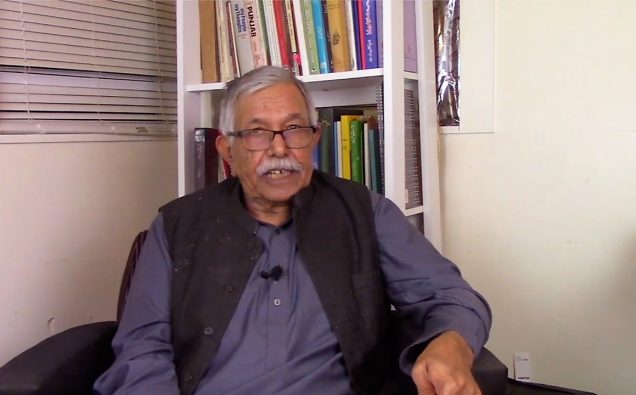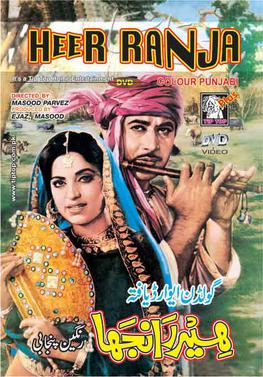
Waris Shah was deeply conscious of the literary craftsmanship and the profundity of thought that had gone into the writing of his epic poem Heer. In fact, upon completion of his magnum opus, Shah declared that he had accomplished something unique in the history of Punjabi literature.
The popularity of Heer – with its unforgettable portrayal of the lovers Ranjha and Heer and other protagonists and villains in the society, and self-serving clerics and elites – stands testament to the poet’s claim.
The poem also continues to hold literati in awe, especially academics and students of the Punjabi literature, culture and history as it offers a kaleidoscopic gaze into the 18th century society, with several aspects of human experience continuing to play out today.
In a latest literary endeavor to understand the multiple meanings of the Shah’s poem, Dr. Manzur Ejaz, a known authority on Punjabi language and literature, has compiled a years-long interpretation of the work in Punjabi language.
Named “Warisnama,” the interpretation will be published in half a dozen volumes in a couple of months. The 631 stanzas will be explained with a glossary, simple summary and discussion on each one of them.
“I have tried to understand layers of meanings of the epic poem as a literary work and the story,” Dr. Ejaz told Views and News.
Dr. Ejaz is author of several books and papers on Punjabi literature and poetry and has also recorded his interpretation of Heer for his Wichaar YouTube channel.
According to the author, Waris Shah’s narration of the Heer is different from a variety of angles.
For instance, it infuses the love story of Heer and Ranjha with the Sufi thought in Islam.
Look at the beginning and the ending.
The story opens with famous lines:
اول حمد خدائ دا ورد کیجے، عشقَ کیتا سو جگّ دا مول میاں
۔ پہلے آپ ہے رب نے عشقَ کیتا، معشوق ہے نبی رسول میاں
۔ عشقَ پیر فقیر دا مرتبہ ہے، مرد عشقَ دا بھلا رنجول میاں
۔ کھلے تنھاں دے باغ قلوب اندر، جنہاں کیتا ہے عشقَ قبول میاں
It concludes with a popular couplet:
عدلی راجا ایہہ نیک نے عمل تیرے، جس ہیر ایمان دوایا ای
۔ وارث شاہ میاں بیڑی پار تنھاں، کلمہ پاک زبان تے آیا ای
Shah’s predecessors including Bulleh Shah explored the motif and meanings of the Heer’s story (known as Qisssa in Punjabi) through smaller version of poems called “Kafi.”
But Shah took the story of Heer to an entirely different, much broader level, examining and critiquing the society – conservatism of the religious clerics and greed of the elites vis-à-vis purity and selflessness of lovers, Heer and Ranjha.
Some of the characters that Shah, called Shakespeare of the Punjabi language, looked at in the poem continue to echo in the societal battles between the status quo powers and younger generations that tends to be progressive and liberal.
Perhaps, one of the greatest qualities of Heer Waris Shah lies its universal appeal.
“These days, it has become a fashion to hail writers as universal. But Waris Shah is a genuinely universal poet. The first part of the poem makes us believe that Ranjha is a Muslim, a follower of the Sufi tradition.
“But look at the second part, where he transitions into a Jogi and represents a philosophical current of the Hindu thought of that time,” Dr Ejaz says, illustrating the universality of the work.
Waris Shah and the love story of Heer remain immensely popular in both the Indian and Pakistani Punjabs, even in several other parts where Punjabi is not spoken.
In Pakistan, Heer Ranjha and other characters have become metaphors in common parlance on the forces of good and parochialism in the society. The 1970s film Heer Ranjha with its Noor Jehan’s eternally famous songs and enchanting tunes of flute (which Ranjha plays) is considered an unrivaled classic.

Indian writer Amrita Pritam invoked Waris Shah and his work, when she cried out at the excruciating treatment of women during the bloodshed and chaos that marred the 1947 freedom of India and Pakistan, summoning the poet to speak from his grave at the catastrophe that unfolded along the historic River Chenab.
Manzur Ejaz, a Pakistani-American based in Washington, has devoted his life to understanding and teaching the Punjabi literature and Sufi poetry – and is widely acknowledged to be a well-placed scholar to offer a window into the study of Waris Shah’s great epic and its timeless themes.
Waris Shah’s Heer is unique in its literary treatment of the famous Punjabi story that had its origins around the Jhang area of Punjab centuries ago, readers can expect a rich extrapolation of the work .
For those of us who have learnt some finer points of the Punjabi poetry from Dr. Manzur Ejaz, it is hard to wait to have the volumes with us as a valuable addition to our understanding of Heer Waris Shah.














